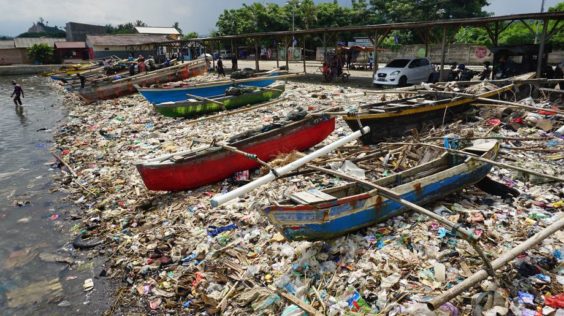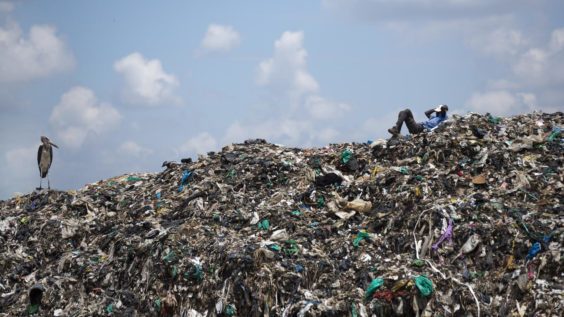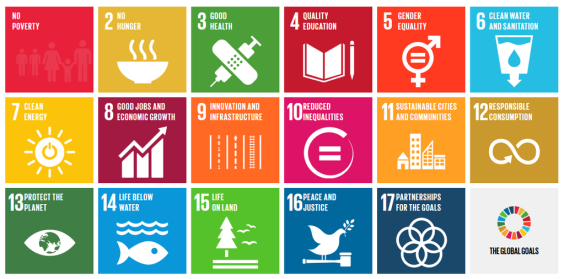Re Ian Bremmer 'Could third-party candidates upend the 2024 US election?' 3 April The current political movement in the USA…
World of Waste and Imbalance
Written by Diana Thebaud Nicholson // July 11, 2019 // Environment & Energy, Sustainable Development // Comments Off on World of Waste and Imbalance
11 July
The World’s 2-Billion-Ton Trash Problem Just Got More Alarming
Humans generated 2.01 billion tons of solid waste in 2016 and by 2050, that could rise to 3.4 billion tons, according to the World Bank. About 12% of all municipal waste in 2016 was plastic — 242 million tons of it. The solution could lie in new technologies and a change in social behavior that reduces and even eliminates the need for landfills and incinerators. Here are some of the ways that companies, local authorities and startups around the world are tackling the problem.
(Bloomberg) … at Malaysia’s Port Klang, Environment Minister Yeo Bee Yin told a group of journalists in May she would send the maggot-infested rubbish back where it came from.
Yeo was voicing a concern that has spread across Southeast Asia, fueling a media storm over the dumping of rich countries’ unwanted waste. About 5.8 million tons of trash was exported between January and November last year, led by shipments from the U.S., Japan and Germany, according to Greenpeace.
Now governments across Asia are saying no to the imports, which for decades fed mills that recycled waste plastic. As more and more waste came, the importing countries faced a mounting problem of how to deal with tainted garbage that couldn’t be easily recycled.
“Typically, 70% of a shipment can be processed, and the other 30% is contaminated with food,” said Thomas Wong, manager of Impetus Conceptus Pte, a Singaporean company that shreds locally produced plastic waste before sending it to recycling mills in Malaysia and Vietnam. Contaminated trash is sent to incinerators and landfills for a fee, but some recyclers “just find a corner and burn it,” Wong said. “The smoke smells just like palm oil, so they hide in a plantation and light up at night.”
Greenpeace investigations in Indonesia, Malaysia and Thailand revealed illegal recycling, open burning, water contamination and a rise in illnesses tied to pollution, the organization said in an April 23 report.
When China banned imports in January 2018, it started a domino effect. Shipments were diverted to Southeast Asia which soon became overwhelmed, forcing governments to take action.
Malaysia announced a ban in October. Thailand stopped issuing import licences last year and will likely impose a ban in 2020, according to Yash Lohia, an executive director at Indorama Ventures Pcl, a Bangkok-based plastics producer and recycler. The Philippines said it is sending 69 containers of garbage back to Canada. Indonesia said it will tighten waste-import rules after discovering shipments containing toxic waste. India and Vietnam have also announced restrictions.
… social media have ensured public awareness of the problem in both developing countries and the wealthy nations that export the trash. That will make it increasingly difficult to export unwanted refuse.
2018
22 April
The theme of Earth Day 2018 is End Plastic Pollution. “Earth Day 2018 is dedicated to providing the information and inspiration needed to fundamentally change human attitude and behavior about plastics,” according to Earth Day Network.
7 things we’ve learned about Earth since the last Earth Day
(Vox) Our understanding of Earth — and how we’re changing it — just keeps expanding.
1) The plastic problem is even worse than we thought
The plastic crisis is a truly global one, and the numbers are staggering: A 2015 study found that between 4.8 and 12.7 million metric tons of plastic makes it into the ocean from land each year. By 2050, there will be more plastic than fish in the ocean by weight.
Since plastic is synthetic, there are few natural processes that break it down, allowing bags, straws, and packaging to linger for decades if not centuries. And we’re not very good at containing it to landfills. About 32 percent of plastics make out into nature, where it often end up in the bellies of fish, birds, and whales. And, as it turns out, potentially in our stomachs too.
In one investigation, the nonprofit Orb Media found plastic fibers in 83 percent of drinking water samples all over the world, with some of the highest levels in drinking fountains at the US Capitol. In a separate investigation published this year, it found microplastic particles in 93 percent of the bottled water samples it tested (250 bottles from 11 leading brands including Dasani and Aquafina).
 Plastic waste accumulates at a dock in Lampung, Indonesia Barcroft Media/Getty Images
Plastic waste accumulates at a dock in Lampung, Indonesia Barcroft Media/Getty Images
We must kill plastic to save ourselves
By Rick Smith, executive director of the Broadbent Institute, and co-author of two books on the human health effects of pollution
Plastic, it turns out, never really disappears. In response to time and sunlight, or the action of waves, it just gets mushed into smaller and smaller bits. These microscopic particles then enter the food chain, air and soil. In the past couple of years, scientists have started to find these particles in an astonishing range of products including table salt and honey, bottled and tap water, shellfish and … beer. In one recent study, 83 per cent of tap water in seven countries was found to contain plastic micro-fibres.
The issue is our society’s addiction to plastic itself. Those plastic micro-fibres I mentioned? Scientists are now saying that one of the primary sources in our drinking water is the lint that comes off the synthetic fabric of our clothing. It’s not just the plastic we’re throwing away that’s the problem; it’s the plastic items we surround ourselves with every day.
The new science on plastic micro-particles is stunning and I’m guessing only the tip of a toxic iceberg. The good news? The vast quantities of plastic crap in our lives is a recent phenomenon, so we know that other habits, other packaging and other materials are possible.
21 March
Ocean plastic predicted to triple within a decade
(CNN) Without intervention soon, the amount of plastic littering the world’s oceans is expected to triple within a decade, a new UK government report warns.
The “Foresight Future of the Sea” report from the UK Government Office for Science said our oceans have seen “unprecedented change as a result of direct human activity and climate change.”
It identified the rise of plastic in oceans, along with rising temperatures and sea levels and chemical pollution, as some of the biggest problems the marine environment faces.
The report found that 70% of marine litter is non-degradable plastic which is projected to increase threefold between 2015 and 2025.
2017
22 November
What’s in your harbour? Scientist appalled by Newfoundland’s underwater trash problem
Pottery, plastics and pedal bikes just some of the debris found by researchers
“Many of the new garbage contains plastic. We’re seeing vinyl siding, windows, carpet, flooring. We see household items such as fridges, stoves, washers — barbecues are very common in harbours around Newfoundland — tools [and] table saws,” he told CBC Radio’s the Broadcast.
“And the number of pedal bikes are just incredible in our harbours for some reason.”
The purpose of the survey, conducted from 2007 to 2016, was to study the effects of harbour infrastructure on fish and fish habitat.
But over the course of almost a decade, it was the amount of garbage steadily accumulating that really stood out.
21 November
Drowning in garbage (with video)
Story, photos and videos by Kadir van Lohuizen | Noor
If the world is not prepared to think about waste reduction and actually treat garbage as a resource, future generations will drown in their own waste.
(WaPost) The world generates at least 3.5 million tons of solid waste a day, 10 times the amount a century ago, according to World Bank researchers. If nothing is done, that figure will grow to 11 million tons by the end of the century, the researchers estimate. On average, Americans throw away their own body weight in trash every month. In Japan, meanwhile, the typical person produces only two-thirds as much. It’s difficult to find comparable figures for the trash produced by mega-cities. But clearly, New York generates by far the most waste of the cities I visited: People in the broader metropolitan area throw away 33 million tons per year, according to a report by a global group of academics published in 2015 in the journal of the National Academy of Sciences. That’s 15 times the Lagos metropolitan area, their study found.
20 November
Canada’s waste problem and finding a fix (video)
(CBC The National) Does Canada have a waste problem? Ask the Philippines and they’ll point to the over 100 containers full of garbage that Canada dumped in Manila. Meanwhile off the coast of Newfoundland and Labrador, a research project has found massive piles of garbage in the ocean.
25 July
Plastic Garbage Patch Bigger Than Mexico Found in Pacific
Yet another floating mass of microscopic plastic has been discovered in the ocean, and it is mind-blowingly vast.
A new discovery of a massive amount of plastic floating in the South Pacific is yet another piece of bad news in the fight against ocean plastic pollution. This patch was recently discovered by Captain Charles Moore, founder of the Algalita Research Foundation, a non-profit group dedicated to solving the issue of marine plastic pollution.
Moore, who was the first one to discover the famed North Pacific garbage patch in 1997, estimates this zone of plastic pollution could be upwards of a million square miles in size.
19 July
A Whopping 91% of Plastic Isn’t Recycled
Billions of tons of plastic have been made over the past decades, and much of it is becoming trash and litter, finds the first analysis of the issue.
(National Geographic) Mass production of plastics, which began just six decades ago, has accelerated so rapidly that it has created 8.3 billion metric tons—most of it in disposable products that end up as trash. If that seems like an incomprehensible quantity, it is. Even the scientists who set out to conduct the world’s first tally of how much plastic has been produced, discarded, burned or put in landfills, were horrified by the sheer size of the numbers.
Plastic takes more than 400 years to degrade, so most of it still exists in some form. Only 12 percent has been incinerated.The study was launched two years ago as scientists tried to get a handle on the gargantuan amount of plastic that ends up in the seas and the harm it is causing to birds, marine animals, and fish. The prediction that by mid-century, the oceans will contain more plastic waste than fish, ton for ton, has become one of the most-quoted statistics and a rallying cry to do something about it.
20i6
 A man who scavenges for a living takes a rest next to a Marabou stork on top of a mountain of garbage at the dump in the Dandora slum of Nairobi, Kenya. (Ben Curtis / Associated Press)
A man who scavenges for a living takes a rest next to a Marabou stork on top of a mountain of garbage at the dump in the Dandora slum of Nairobi, Kenya. (Ben Curtis / Associated Press)
22 April
The world’s trash crisis, and why many Americans are oblivious
(LA Times) As nations around the globe observe Earth Day, one of the most daunting issues facing the world is the mounting waste problem, which impairs public health, pollutes the environment and threatens to drown some poor countries in toxicity.
More than half the world’s population does not have access to regular trash collection, a grim statistic given the amount of garbage produced globally.
Some experts say the globe’s trash troubles are at a crisis level. Here are a look at the problem and some possible solutions:
Each year, nations generate 1.3 billion tons of waste. That’s expected to soar to 4 billion tons by 2100, according to Ede Ijjasz-Vasquez, senior director for the World Bank’s Social, Urban, Rural and Resilience Global Practice.
What are the threats and ramifications of the global trash problem?
The threat of waste to the environment, health and safety is huge. And so are the financial and social ramifications, waste experts say.
Pollution runs into rivers and seeps into ground water. Flooding is caused by garbage clogging drains, and the atmosphere can be poisoned by the toxic discharge from trash.
When waste is not collected, the frequency of illness such as diarrhea doubles and acute respiratory infection — linked to the burning of waste — is six times higher, Ijjasz-Vasquez said.
In less developed nations, uncollected waste is typically heaviest near less affluent neighborhoods and slums. For scavengers, discarded food in the heaps of trash provides sustenance and a livelihood.
2015
17 September
Welcome to the World of Waste and Imbalance
Dr. Paul Shrivastava is Executive Director of Future Earth, an international research programme coordinating research on global sustainability. Paul is former David O’Brien Distinguished Professor of Sustainable Enterprise at the John Molson School of Business, Concordia University, Montreal. He has over 25 years experience in management education, entrepreneurship, and as a consultant to major multinational corporations
(Huff Post) The world has enough for everyone’s need, but not for everyone’s greed, said Mahatma Gandhi in 1947. Gandhi’s prescient words came on the cusp of a great acceleration in human consumption and production that now results in “Earth overshoot day.”
We are borrowing from our future and we are altering Earth’s natural cycles to the extent that there is a mountain of evidence we have entered a new geological epoch — the Anthropocene.
This world we have created is a world of waste and imbalance, where 800 million go hungry each night, but more than two billion suffer obesity; and while scarcity and shortages plague some places, waste is prevalent: 30 percent of electricity produced, 40 percent of food produced and 50 percent of transportation capacity is wasted. Every dollar of GDP produced produces more than a dollar in unaccounted pollution, waste, health risks and loss of nature.
At the heart of the problem is the cycle of consumption and production. Goal 12 of the Sustainable Development Goals, which will be agreed to at a UN summit in New York later this month, attempts to tackle this head on, but the wording is so vague in places that all nations will be able to demonstrate some progress without converting to a truly sustainable model.
On the one hand, consumers are not receiving a price signal that their choices are driving ecological collapse. Recent research led by Beatrice Crona at the Stockholm Resilience Centre, for example, shows that when fish stocks collapse in a region, fishermen move further afield to source the same fish and fish prices remain more or less stable. It’s only when the entire fish stock on a very large scale is on the verge of collapse that consumers start to feel the pinch.
But it may be unfair to focus solely on consumers, for it is the producers who prey on consumer’s insecurities, desires and race for status (ultimately a zero-sum game: we can’t all be better off than everyone else). And of course corporations are locked in a Darwinian fight for survival, driving efficiencies and capitalizing on perverse subsidies for fossil fuels.
To achieve Goal 12, we need systemic transformation of both consumption and production. Our modern economies evolved over two centuries with a single-minded focus on increasing production and productivity. In this pursuit, we have sought to maximize technological, labor and financial efficiencies, and ignored ecological efficiencies. This may have made sense when the oceans, prairies and forests seemed endless, but not when we start pushing against the finite boundaries of space above and rock below. But efficiency alone is not sufficient to create sustainable production and consumption. In some ways, efficiency has the perverse effect of making things much cheaper, encouraging total consumption.
We need systemic solutions and the system we are talking of includes both natural and human capital, in addition to manufactured and financial capitals. We cannot keep ignoring nature and the ecosystem services it provides as “free” goods. If we want nature to remain productive at levels we have seen in the past, we will need to invest in maintenance of natural systems. We need to value natural processes, both for their instrumental value, their aesthetic value and spiritual value.
This will take a reform of business. Businesses are the main engine of human-wealth production. Inadvertently, they are also the main producers of pollution and risk. We need to implement full-cost accounting of production in businesses. That means accounting for natural and human capital in creation of financial, manufactured capital and internalizing so called “externalities.”
We need to stop the misinformation from businesses and insist on disclosure of their pollution and use of natural-resource use. When banks assess the credit rating of a company, they should include the ecological sustainability of that business. The Global Economic Dynamics and the Biosphere program, based at the Royal Swedish Academy of Sciences, argues that when credit-ratings agencies such as Standard and Poor, Moody’s and Fitch, who together control the market, hand out triple-A ratings to banks and countries, these ratings should include an element of long-term environmental sustainability. The divestment campaign will certainly prod the ratings agencies in the right direction.
Some major multinational corporations, for example Unilever, Puma and Virgin, are becoming increasingly vocal about the need for politicians to step up and create a level playing field for all businesses. Even Statoil recognizes the risks of burning all fossil-fuel reserves are too grave to contemplate.
Implementing sustainable production and consumption will require a change in values and world views, a change in regulations, in business practices, and personal choices. We need to expose the fallacy that material consumption results in satisfaction and improved wellbeing. Once our basic needs — food, clothing, shelter, education, healthcare — are met, acquiring and consuming more material goods fails to create more happiness. Goal 12 is a call to balance economic production and consumption with social and ecological wellbeing.
This post is part of a series produced by The Huffington Post, “What’s Working: Sustainable Development Goals,” in conjunction with the United Nations’ Sustainable Development Goals (SDGs). The proposed set of milestones will be the subject of discussion at the UN General Assembly meeting on Sept. 25-27, 2015 in New York. The goals, which will replace the UN’s Millennium Development Goals (2000-2015), cover 17 key areas of development — including poverty, hunger, health, education, and gender equality, among many others. As part of The Huffington Post’s commitment to solutions-oriented journalism, this What’s Working SDG blog series will focus on one goal every weekday in September. This post addresses Goal 12.
Future Earth: Applying complex systems thinking to implementing the Sustainable Development Goals
This session will discuss progress to develop the science-policy interface to support the SDGs and ensure the goals’ implementation is informed by evidence. Implementation will require integrated systemic changes. Systems-thinking is needed to ensure that environment and development are integrated at all levels and in all countries. Implementation will require developing a bare minimum set of integrated indicators.
Sustainable development goals: all you need to know
With the UN summit on the sustainable development goals looming, find out more about the 17 initiatives that could transform the world by 2030
What are the sustainable development goals?
The sustainable development goals (SDGs) are a new, universal set of goals, targets and indicators that UN member states will be expected to use to frame their agendas and political policies over the next 15 years.
The SDGs follow and expand on the millennium development goals (MDGs), which were agreed by governments in 2001 and are due to expire at the end of this year.
Why do we need another set of goals?
There is broad agreement that, while the MDGs provided a focal point for governments – a framework around which they could develop policies and overseas aid programmes designed to end poverty and improve the lives of poor people – as well as a rallying point for NGOs to hold them to account, they were too narrow.




